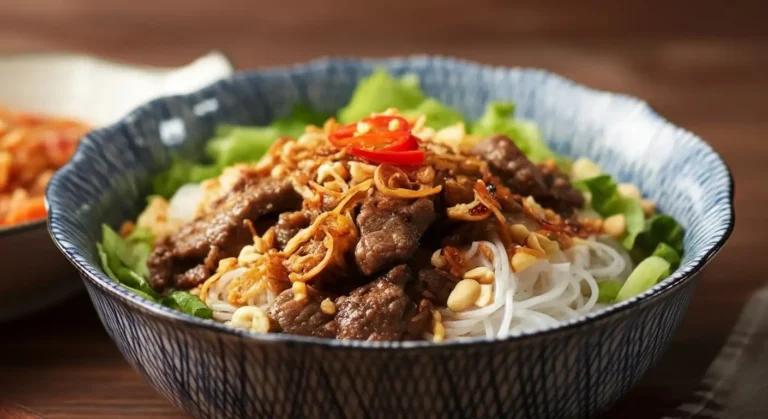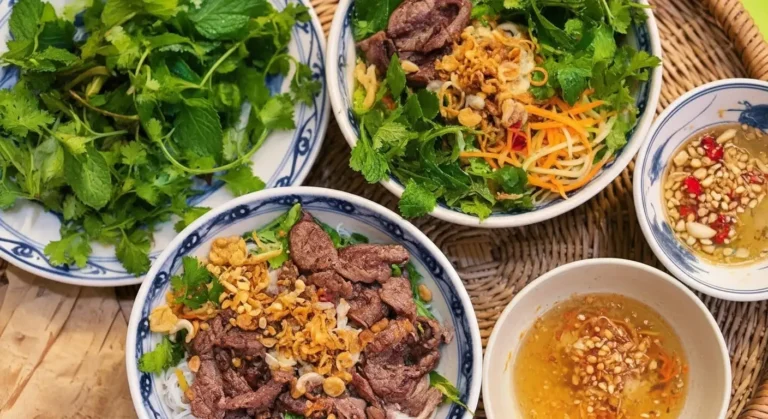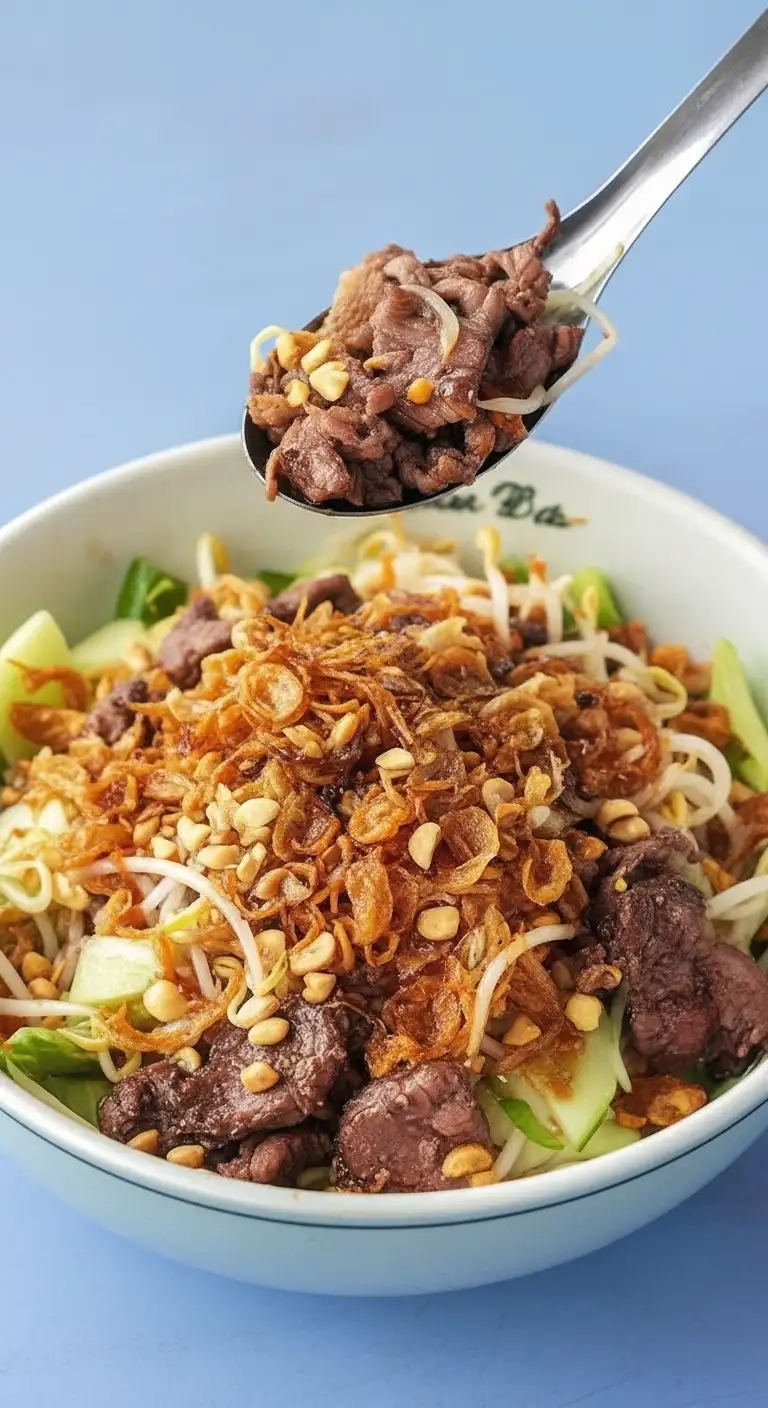Bún Bò Nam Bộ (pronounced “Boon Boh Nahm Boh”) literally translates to “noodles with beef from the South.” Despite its name, this dish is ironically one of the most famous and beloved street foods in Hanoi (Northern Vietnam). It is a perfect, refreshing contrast to Vietnam’s heavy, hot noodle soups like Phở and Bún Bò Huế, as it is served without a hot broth, making it a “warm noodle salad” or “dry noodle dish.”

Bún Bò Nam Bộ: The Basics
The Noodle (Bún): The foundation is a generous serving of fine, white, and soft rice vermicelli noodles (bún).
The Protein (Bò): Thin slices of beef (bò) are marinated with lemongrass, garlic, fish sauce, and a touch of sugar, then quickly stir-fried or grilled until tender and flavorful.
The Assembly (Salad Base): The noodles and beef are served over a vibrant bed of fresh, crunchy vegetables and herbs, including:
Lettuce (often butter lettuce)
Cucumbers (julienned)
Bean sprouts
Aromatic herbs like mint, basil, and cilantro.
The Toppings: The bowl is finished with essential crunchy elements:
Roasted Peanuts: Crushed or chopped, adding a nutty flavor and texture.
Hành Phi: Crispy fried shallots, which add a savory, garlicky crunch.
The Sauce (Nước Chấm): The dish is dressed with a generous amount of Nước Chấm (Vietnamese dipping sauce), a perfect balance of sweet, sour, salty, and spicy, made from fish sauce, sugar, water, lime juice, chili, and minced garlic.
Variations of Bún Bò Nam Bộ
While the dish’s fundamental nature is consistent across Vietnam—a dry noodle dish with beef—variations generally involve the addition of extra protein:
| Name | Key Distinction | Focus Region |
|---|---|---|
| Bún Bò Nam Bộ (Classic) | Stir-fried beef is the only meat. Focus is on fresh herbs, beef flavor, and the Nước Chấm dressing. | North (Hanoi) |
| Bún Bò Xào | (Literally "stir-fried beef vermicelli") An alternative name for the same dish, emphasizing the cooking method of the beef. | General/North |
| Bún Bò Nem/Chả Giò | Includes fried spring rolls (nem rán or chả giò) alongside the stir-fried beef. The rolls are often broken up over the noodles. | South (Saigon/HCMC) |
| Bún Thịt Nướng | A very similar, dry noodle dish, but the beef is replaced by charcoal-grilled pork (thịt nướng). This is extremely popular in the South. | Southern & Central Vietnam |

How to Eat Bún Bò Nam Bộ
Bún Bò Nam Bộ is an interactive dish—it must be properly mixed before consumption to combine the contrasting temperatures and textures.
Dressing the Bowl: The Nước Chấm sauce is usually served in a separate small bowl or pre-poured at the bottom of the large bowl. If it’s separate, pour the entire bowl of sauce over the noodles and toppings.
The Essential Mix: Use your chopsticks and/or a spoon to thoroughly mix all the ingredients. You must ensure the sauce coats every strand of noodle, every slice of beef, and all the vegetables and crunchy bits. The magic is in the mix!
Enjoy Warm: The stir-fried beef and warm noodles contrast beautifully with the cool, fresh herbs and cold sauce.
Spice it Up: Add a bit of fresh, sliced chili (or chili sauce) to your bowl for a final flavor kick.
Regional Differences
The most significant difference lies not in the dish’s existence but in the local perception and the small touches that define regional cuisine:
| Region | Regional Culinary Style | Bún Bò Nam Bộ Interpretation | Local Perspective |
|---|---|---|---|
| Northern Vietnam | Subtle, refined, less sweet, emphasizes clean flavors. | The dish is minimalist: often just beef, noodles, fresh herbs, and a generous amount of fried shallots and peanuts. The Nước Chấm is traditionally less sweet. | Ironically, despite being "Southern Beef Noodles," this dish is a major Hanoi specialty and is often found on street corners with dedicated shops. |
| Central Vietnam | Bold, rich, spicy, and savory; often prefers dry noodle dishes. | Less common as a regional focus than the North or South, but places that serve it often use the local style, favoring a slightly more savory/saltier Nước Chấm and often incorporating pickled vegetables like papaya. | Central Vietnam is more famous for its own dry noodle dish, Mì Quảng, and the spicy soup, Bún Bò Huế. |
| Southern Vietnam | Sweet, generous, and complex; embraces more sugar and toppings. | Southern versions are typically more generous with extra toppings, such as Chả Giò (spring rolls) and sliced grilled pork, making the bowl very hearty. The Nước Chấm tends to be sweeter to align with the Southern palate. | While the dish is named after the region, it is often referred to as Bún Bò Xào locally, and its fame is arguably more tied to Hanoi's street food scene. |




